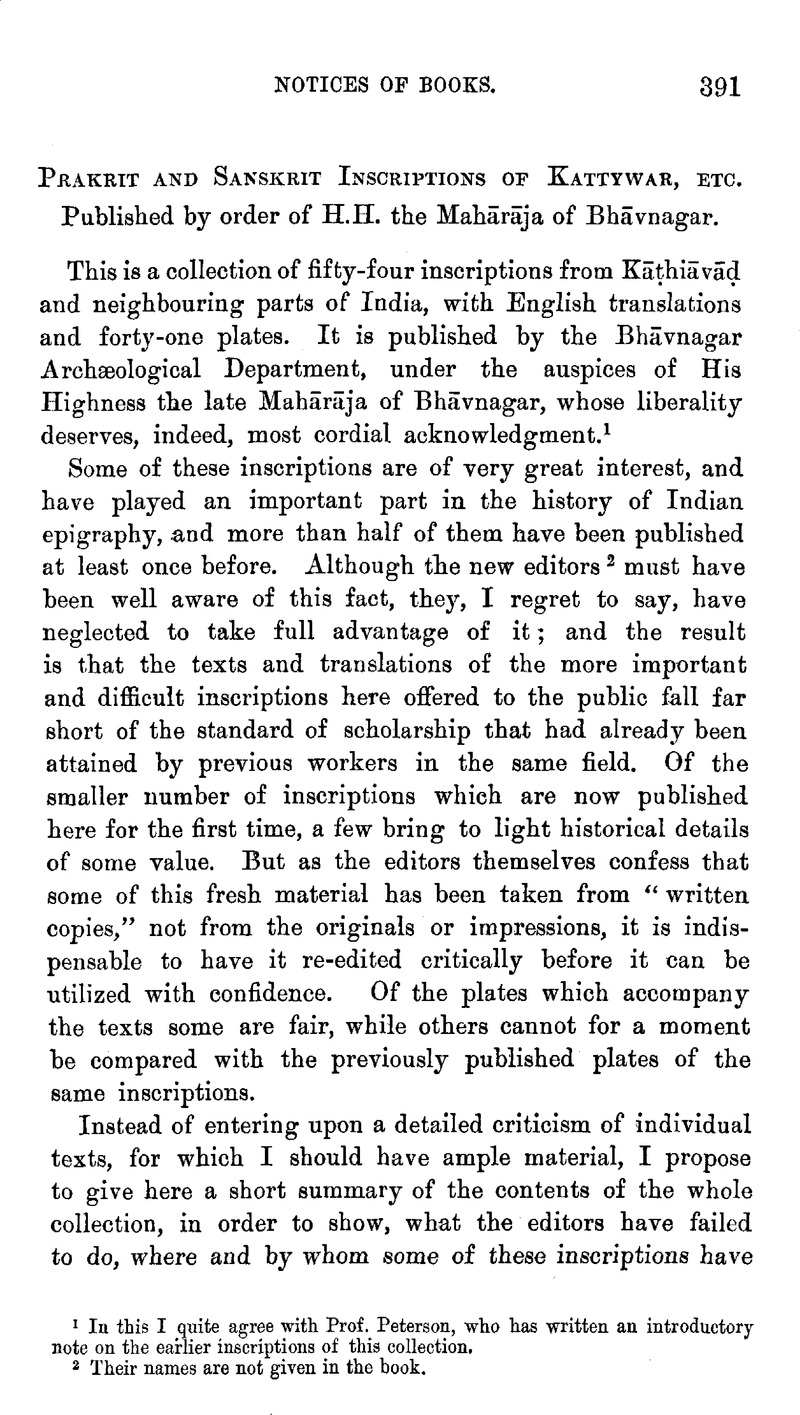No CrossRef data available.
Article contents
Notices of Books - Prakrit and Sanskrit Inscriptions of Kattywar, etc. Published by order of H.H. the Mahārāja of Bhāvnagar.
Review products
Published online by Cambridge University Press: 15 March 2011
Abstract

- Type
- Notes of the Quarter
- Information
- Copyright
- Copyright © The Royal Asiatic Society 1896
References
page 391 note 1 In this I quite agree with Prof. Peterson, who has written an introductory note on the earlier inscriptions of this collection.
page 391 note 2 Their names are not given in the book.
page 392 note 1 These are marked with an asterism.
page 393 note 1 The exact date, saṁ 252 Vaiśākha-ba 15 (not, as given here, Vaiśākha-bahu 5), corresponds perhaps to the 10th April, a.d. 571, when there was a solar eclipse which was not visible in India. In the first line of this inscription the plate has sapatna (not saṁpanna, as given in the text), which is important: see DrHultzsch, in Ep. Ind., vol. iii, p. 319Google Scholar.
page 393 note 2 The date of this inscription perhaps corresponds to the 24th August, a.d. 629, when also there was a solar eclipse which was not visible in India.
page 393 note 3 The photolithograph of the first plate, now published, is a reverse.
page 394 note 1 The dates of the inscriptions 1 and 2 are the earliest known dates for the list of Guhila chiefs given in Ind. Ant., vol. xvi, p. 346.
page 394 note 2 The name of this chief also occurs in a fragmentary inscription at Ar, near Udaypur, published with a photolithograph by ProfBendall, in his Journey, p. 82Google Scholar.
page 394 note 3 In the translation the prince Siṁha has received here the name Aghasiṁha, which is deduced from the words of the text babhūva tasmād atha Siṁha-nāmā. Mallata in the text is Maṁtaṭa, and in the translation Maṇttaṭa.
394 note 4 The date given here is saṁvat 1485 śāke 1350 varṣe Māghaśukla 3, while in reality the original has saṁvat 1485 varṣe Māghasudi 3 Guru-dine.
page 395 note 1 I very much doubt the correctness of this. At any rate, the given date is wrong for Vikrama-saṁvat 1597, and Rāyamalla's rule must have ended long before that time. For the expired Kārttikādi Vikrama year 1557 the date (Friday, the 6th of the bright half of Vaiśākha, with the nakṣatra Punarvasu) would correctly correspond to Friday, the 23rd April, a.d. 1501, when the 6th tithi of the bright half ended 16 h. 56 m., and the nakṣatra was Punarvasu for 7 h. 13 min. after mean sunrise.
page 395 note 2 No. 1 clearly belongs to the Caulukya dynasty. No. 3 is a copy of the last leaf of a MS. of Nṛsiṁhāranya Muni's Viṣṇubhakticandrodaya.
page 396 note 1 The date of this inscription has met with a most extraordinary fate. According to the translation in the As. Res. it is ‘Sunday, the 3rd of the light fortnight of Phālguna, in the year of Vikrama 1287’; Mr. Kāthavaṭe's text has ‘1293 varṣe śrī-Śrāvaṇa badi 3 Ravau,’ while his translation gives ‘the year 1287,’ and his introduction ‘1297 Samvat’; and now the present edition has ‘1267 varṣe Phālguna-vadi 10 Saumya-dine, Wednesday, the 10th of Fālaguna Vadi (dark half) of the year 1267 of the Vikrama Saṃvata.’
page 397 note 1 On ‘a hard black stone, measuring on its surface 20 ft. by 12 ft.’ The size of this stone is beaten by that of the stone which contains the preceding inscription, No. 2, ‘39 ft. by 31 ft.’


